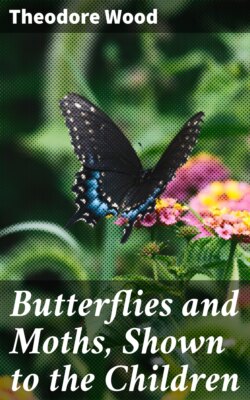Читать книгу Butterflies and Moths, Shown to the Children - Theodore Wood - Страница 7
ОглавлениеPLATE III
1. Peacock Butterfly 2. Peacock Caterpillar
3. Red Admiral Butterfly
PLATE III
THE PEACOCK (1 and 2)
You cannot possibly mistake this beautiful insect for any other British butterfly, for on each of its four wings it has a large eye-like spot, very much like the markings on the tail of a peacock. But the under-side of the wings is quite differently coloured. It is almost as black as charcoal. And the consequence is that when the butterfly sits on the trunk of a tree, with its wings folded over its back, you cannot possibly see it unless you look at it sideways.
Peacock butterflies are very common in August and September, and again in spring, after they have passed through their long winter sleep. They are very fond of sitting on thistle blossoms when the sun is shining, with their wings widely spread. And you may often see them resting on ivy bloom, or sipping the sweet juices of over-ripe plums. During the winter they hide away in outhouses, and sheds, and faggot-stacks. The caterpillars, which feed in large companies on nettle leaves, are black in colour, sprinkled with little white dots, and are quite as thorny as those of the two tortoise-shells. Look for them in June and July. The chrysalids are green, with their heads and bodies rather brighter than their tails, and with a number of gold spots.
PLATE III
THE RED ADMIRAL (3)
I really think that this is the very handsomest of all our British butterflies; for its wings are of the glossiest possible black above, with spots of the purest possible white, and streaks of the brightest possible scarlet. And on their lower surface so many different tints of grey and pink and brown and red are mingled together that I cannot possibly describe them. All that I can do is to advise you to try to catch one of these butterflies and look at it for yourself; and if you do, I am quite sure that you will say that you have never seen a more beautiful insect.
Red Admiral butterflies are nearly always very common from August till October, and again in April and May, and are quite as fond of ivy bloom and the juices of ripe fruits as peacocks. On almost any warm sunny day you may see them flying about in gardens, or on the borders of woods. Their thorny caterpillars, which are yellowish-grey in colour with black markings, and with light yellow lines on each side, may be found feeding on nettle leaves, though not in large companies like those of peacocks and small tortoise-shells. The chrysalids are brown, with gold spots.
